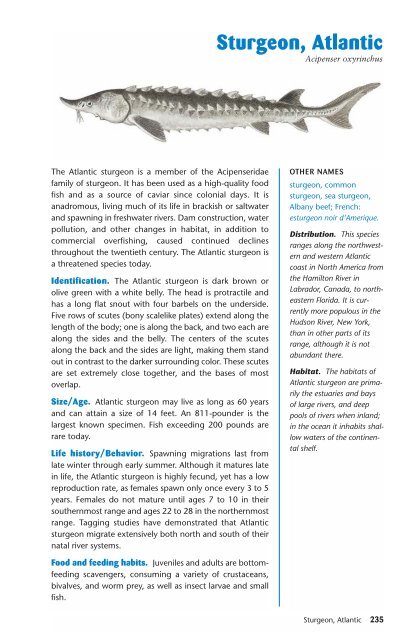Ken Schultz's Field Guide to Saltwater Fish - Macaw Pets store
Ken Schultz's Field Guide to Saltwater Fish - Macaw Pets store
Ken Schultz's Field Guide to Saltwater Fish - Macaw Pets store
Create successful ePaper yourself
Turn your PDF publications into a flip-book with our unique Google optimized e-Paper software.
The Atlantic sturgeon is a member of the Acipenseridae<br />
family of sturgeon. It has been used as a high-quality food<br />
fish and as a source of caviar since colonial days. It is<br />
anadromous, living much of its life in brackish or saltwater<br />
and spawning in freshwater rivers. Dam construction, water<br />
pollution, and other changes in habitat, in addition <strong>to</strong><br />
commercial overfishing, caused continued declines<br />
throughout the twentieth century. The Atlantic sturgeon is<br />
a threatened species <strong>to</strong>day.<br />
Identification. The Atlantic sturgeon is dark brown or<br />
olive green with a white belly. The head is protractile and<br />
has a long flat snout with four barbels on the underside.<br />
Five rows of scutes (bony scalelike plates) extend along the<br />
length of the body; one is along the back, and two each are<br />
along the sides and the belly. The centers of the scutes<br />
along the back and the sides are light, making them stand<br />
out in contrast <strong>to</strong> the darker surrounding color. These scutes<br />
are set extremely close <strong>to</strong>gether, and the bases of most<br />
overlap.<br />
Size/Age. Atlantic sturgeon may live as long as 60 years<br />
and can attain a size of 14 feet. An 811-pounder is the<br />
largest known specimen. <strong>Fish</strong> exceeding 200 pounds are<br />
rare <strong>to</strong>day.<br />
Life his<strong>to</strong>ry/Behavior. Spawning migrations last from<br />
late winter through early summer. Although it matures late<br />
in life, the Atlantic sturgeon is highly fecund, yet has a low<br />
reproduction rate, as females spawn only once every 3 <strong>to</strong> 5<br />
years. Females do not mature until ages 7 <strong>to</strong> 10 in their<br />
southernmost range and ages 22 <strong>to</strong> 28 in the northernmost<br />
range. Tagging studies have demonstrated that Atlantic<br />
sturgeon migrate extensively both north and south of their<br />
natal river systems.<br />
Food and feeding habits. Juveniles and adults are bot<strong>to</strong>mfeeding<br />
scavengers, consuming a variety of crustaceans,<br />
bivalves, and worm prey, as well as insect larvae and small<br />
fish.<br />
Sturgeon, Atlantic<br />
Acipenser oxyrinchus<br />
OTHER NAMES<br />
sturgeon, common<br />
sturgeon, sea sturgeon,<br />
Albany beef; French:<br />
esturgeon noir d’Amerique.<br />
Distribution. This species<br />
ranges along the northwestern<br />
and western Atlantic<br />
coast in North America from<br />
the Hamil<strong>to</strong>n River in<br />
Labrador, Canada, <strong>to</strong> northeastern<br />
Florida. It is currently<br />
more populous in the<br />
Hudson River, New York,<br />
than in other parts of its<br />
range, although it is not<br />
abundant there.<br />
Habitat. The habitats of<br />
Atlantic sturgeon are primarily<br />
the estuaries and bays<br />
of large rivers, and deep<br />
pools of rivers when inland;<br />
in the ocean it inhabits shallow<br />
waters of the continental<br />
shelf.<br />
Sturgeon, Atlantic 235


